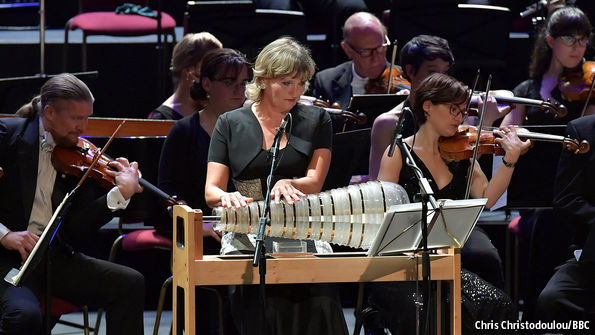The Glass Harmonica – An Instrument For Our Time?
Solving a crossword puzzle one day some 30 years ago, a young Austrian violinist couple named Christa and Gerald Schönfeldinger came across a reference to an instrument they had never heard of, consisting of dozens of glass bowls, and referred to as a glass harmonica. They discovered that the instrument, also known as the armonica, had been invented by Benjamin Franklin, one of America’s founding fathers. During his frequent trips to London the renaissance man—Franklin, who helped write the American constitution, was a scientist and inventor as well—had been inspired by Englishmen’s habit of making music by striking their wet fingers around glass rims.
Not only did the Schönfeldingers solve the crossword puzzle: they set about finding the instrument and learning it. In October their Vienna Glass Armonica Duo celebrates its 25th anniversary, and the couple are also celebrating the long-forgotten instrument’s rising prominence. “We’ve really been noticing a growing interest in the glass harmonica for the past couple of years or so,” says Christa Schönfeldinger. “People are looking for an alternative sound in our noisy world.”

It’s an unusual and quiet sound indeed, as anyone who has ever moved a finger around the ridge of a glass knows. But it’s apparently a sound that appeals to modern ears and composers. At the BBC Proms this summer, Christa Schönfeldinger was the glass harmonica soloist in the British premiere of an orchestral opus by Jörg Widmann, a German composer, called “Armonica”. The Game of Thrones score likewise includes the long-forgotten instrument, as does the original score of “Written on Skin”, an opera written in 2012 by George Benjamin, a British composer, which will be performed at London’s Royal Opera House in January next year. Björk, an experimental Icelandic artist, has also included Franklin’s invention in her songs. And Prospero understands that an oratorio commissioned from Mr Widmann by the Elbphilharmonie, Hamburg’s new concert hall, for its opening in January next year will also feature the glass harmonica.
The glass harmonica operates along the same principle as the wet finger on the glass rims Franklin observed in London. (Performers carry a bowl of water with them.) The difference between the party trick and the concert instrument is that the glass harmonica’s several dozen glass bowls are placed together horizontally on a rotating axis, with each bowl having a specific place and pitch. When the player touches a bowl with his wet finger, he knows that it will produce a specific tone much the same way a piano does.
Just like the Schönfeldingers, Mozart instantly fell in love with the glass harmonica. and he swiftly composed an adagio for it. The instrument was popular then and remained so for several decades. In 1835, the Italian bel canto composer Gaetano Donizetti chose the instrument to accompany Lucia di Lammermoor’s climactic mad scene in the opera named for her.
Because the glass-generated sound has a much higher pitch than traditional orchestral instruments, listeners found it difficult to place, a few reported mental disturbances after hearing it and some even concluded it was a call from beyond the grave. The instrument’s tainted reputation helped lead to its demise. When the Schönfeldingers read about the instrument and wanted to try it out, they found that buying one was virtually impossible. “The glass harmonica is expensive and difficult to make,” explains William Zeitler, for many years one of a handful professional glass harmonica players. “And there’s no such thing as a cheap student model. You have to buy one at $40,000, which means you have to be really committed. You can count the number of glass harmonica teachers on one hand and have fingers left.” A student violin, by contrast, can be had for £100 and a recorder for £5. Most of today’s glass harmonica players are self-taught.
But perhaps realising that traditional instruments offer a finite range of sound options, composers seem to have made the same discovery as Benjamin Franklin. And modern audiences seem to enjoy the ethereal sound that made 19th-century listeners think of death. The question now is how to train more glass harmonica players, and what to train them on. A German glass harmonica maker, who supplied most of Europe, recently decided to retire. “If there are no instruments, nobody will play the glass harmonica,” says Christa Schönfeldinger. Her husband has decided to start making instruments for sale.
There is, however, another tricky twist to the glass harmonica’s growing prominence: performers have to travel to concerts, and that includes airline luggage handling. Many airlines make musicians to pay for an extra seat for their instruments or put them in the hold, where they may suffer irreparable damage. Zeitler reports that luckily the bowls can be stacked together to fit in the overhead bin. But, he admits, “It’s frightening walking through the airport with $40,000 worth of glass in your carry-on.”